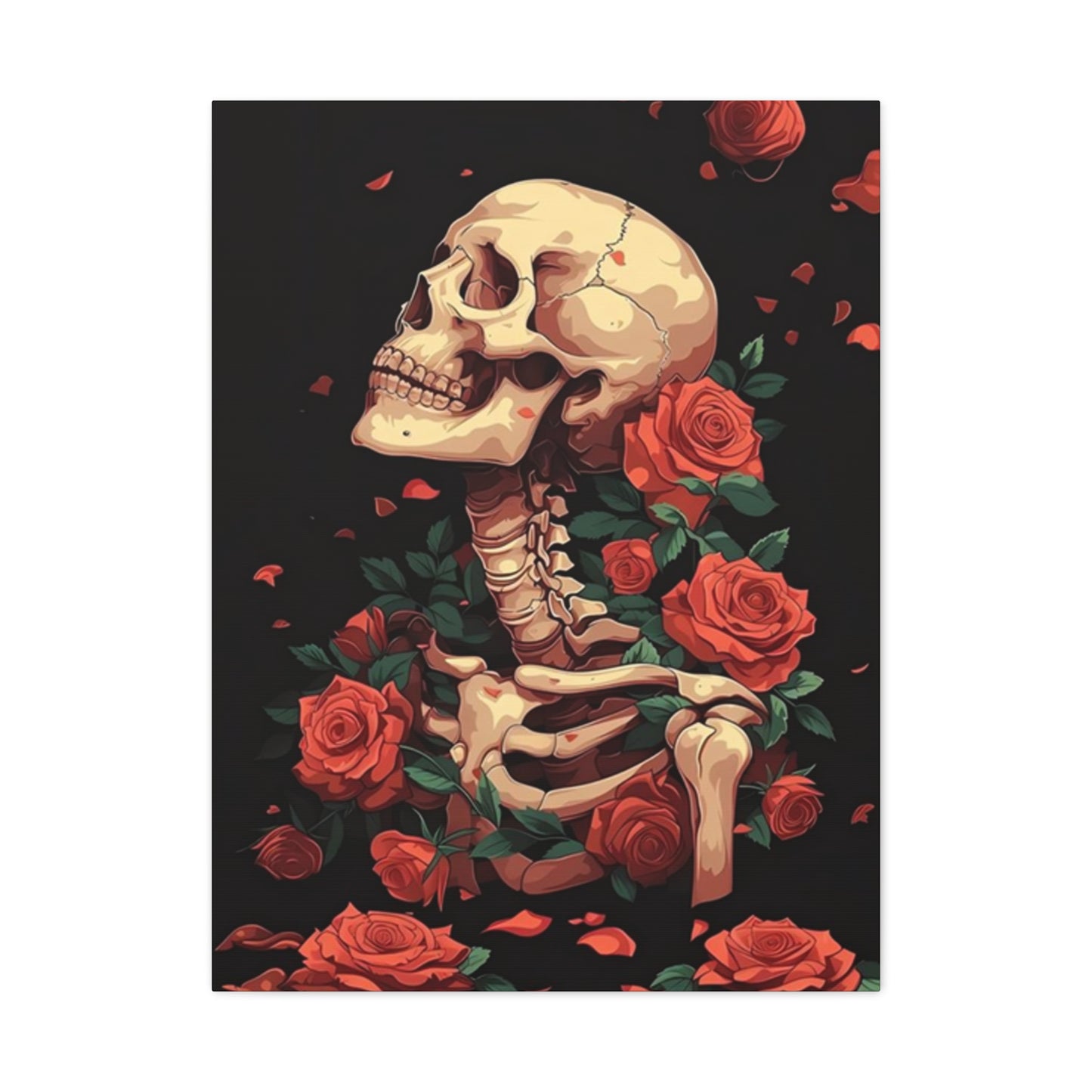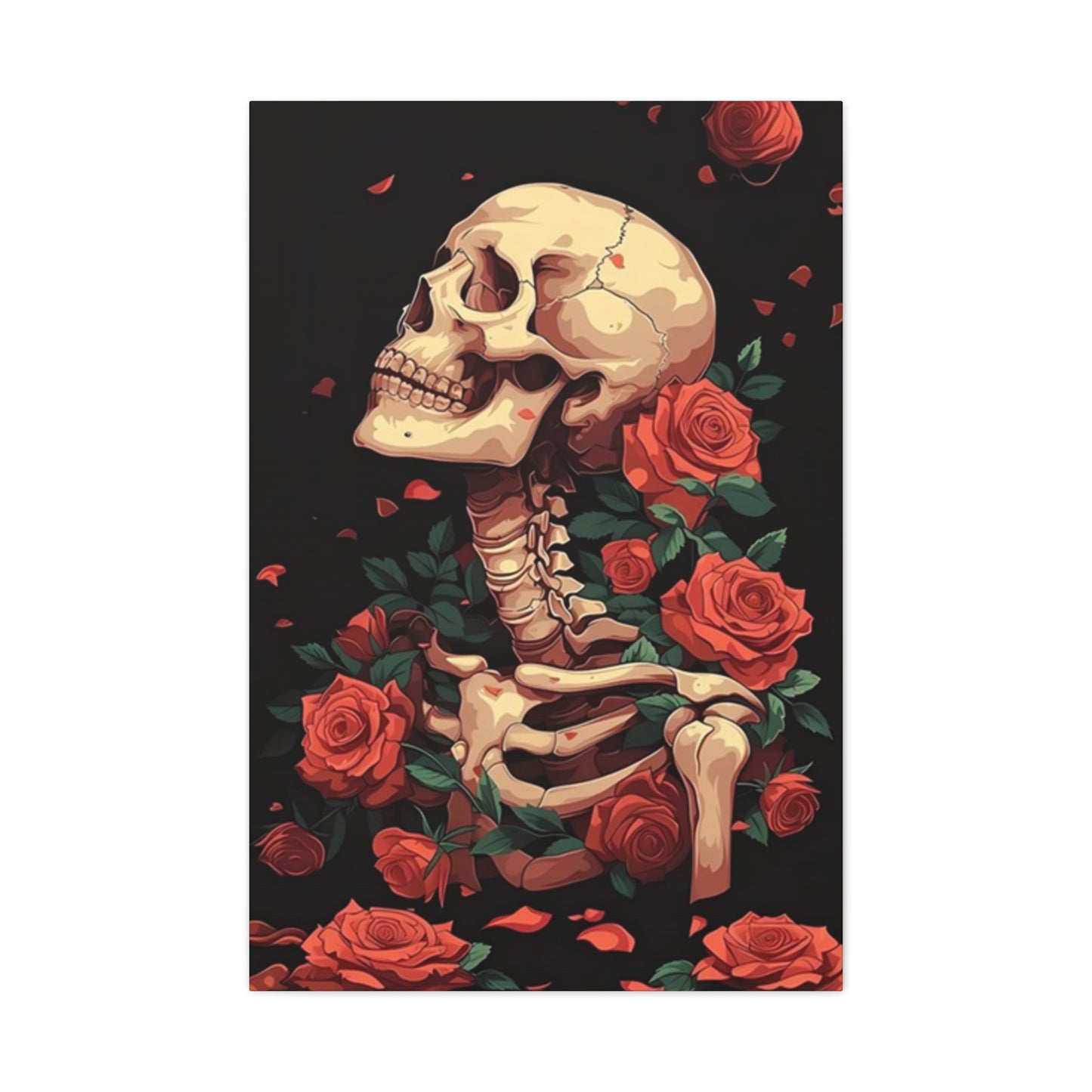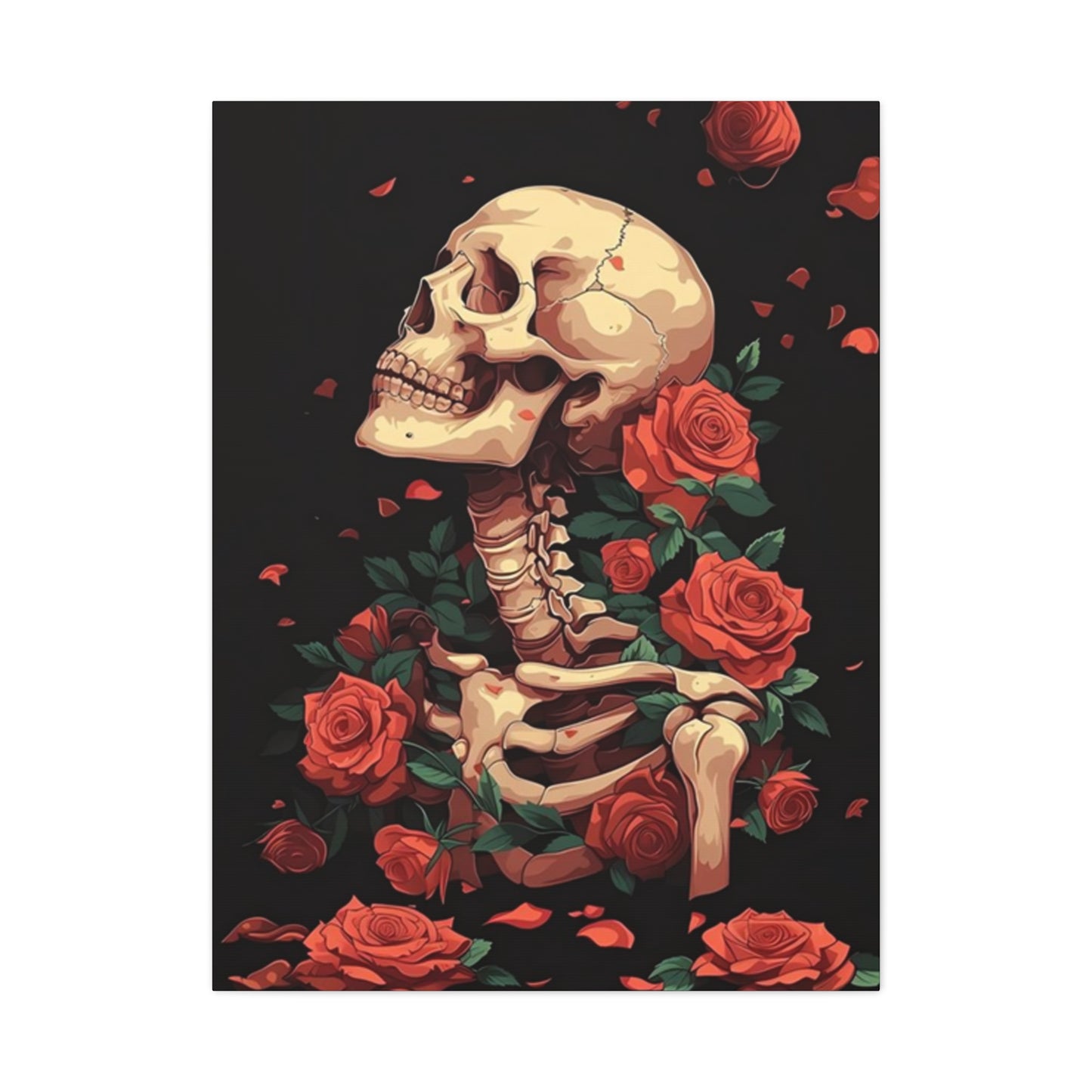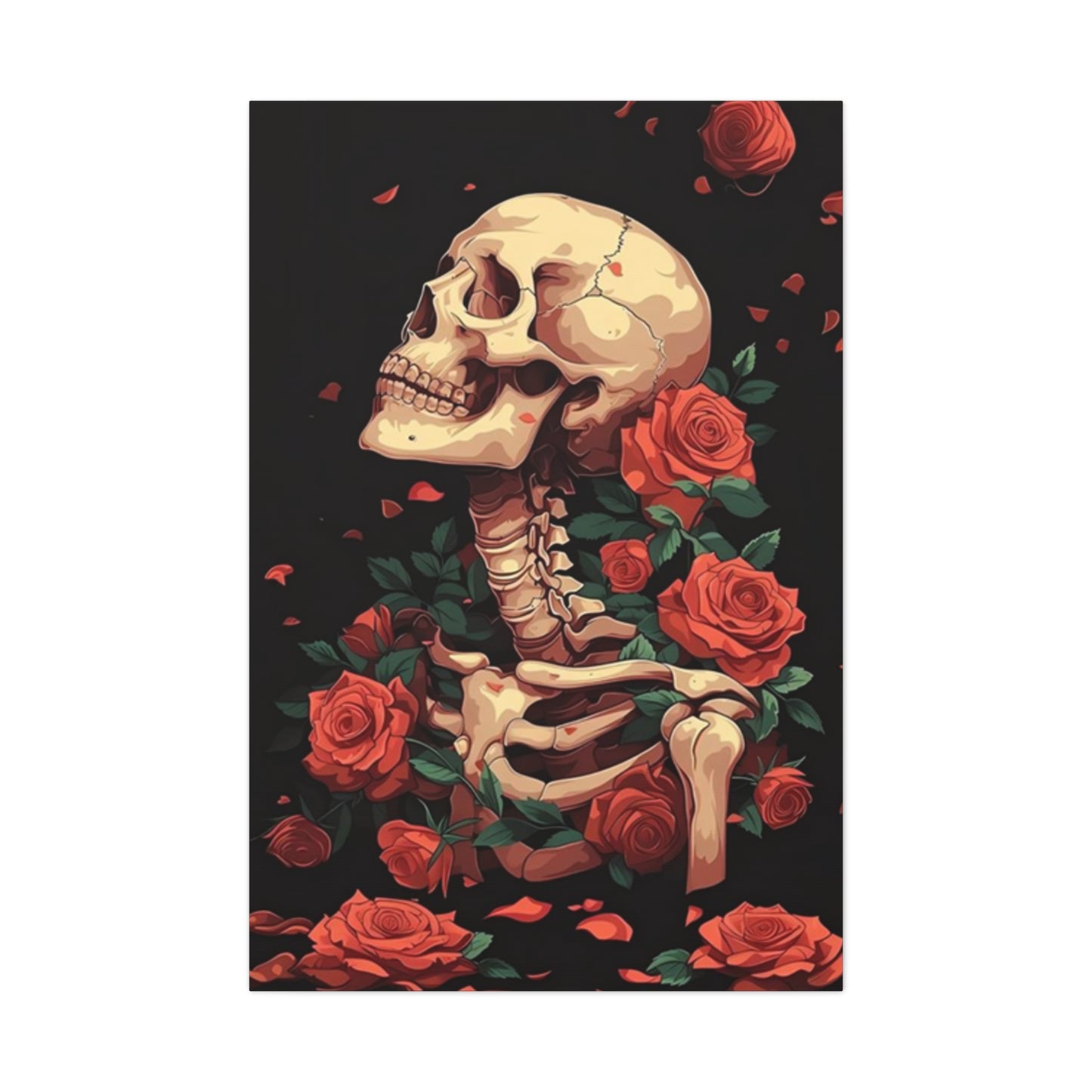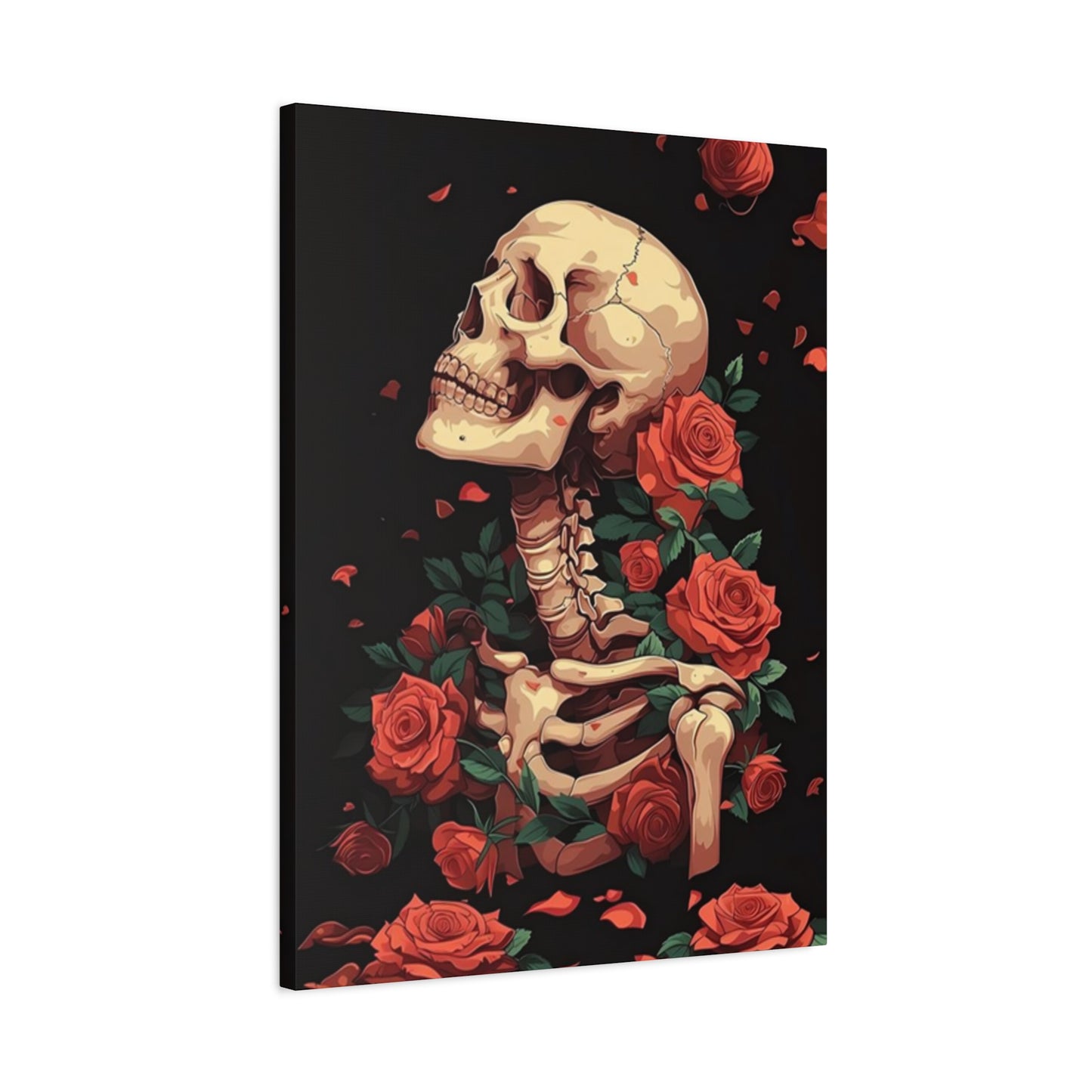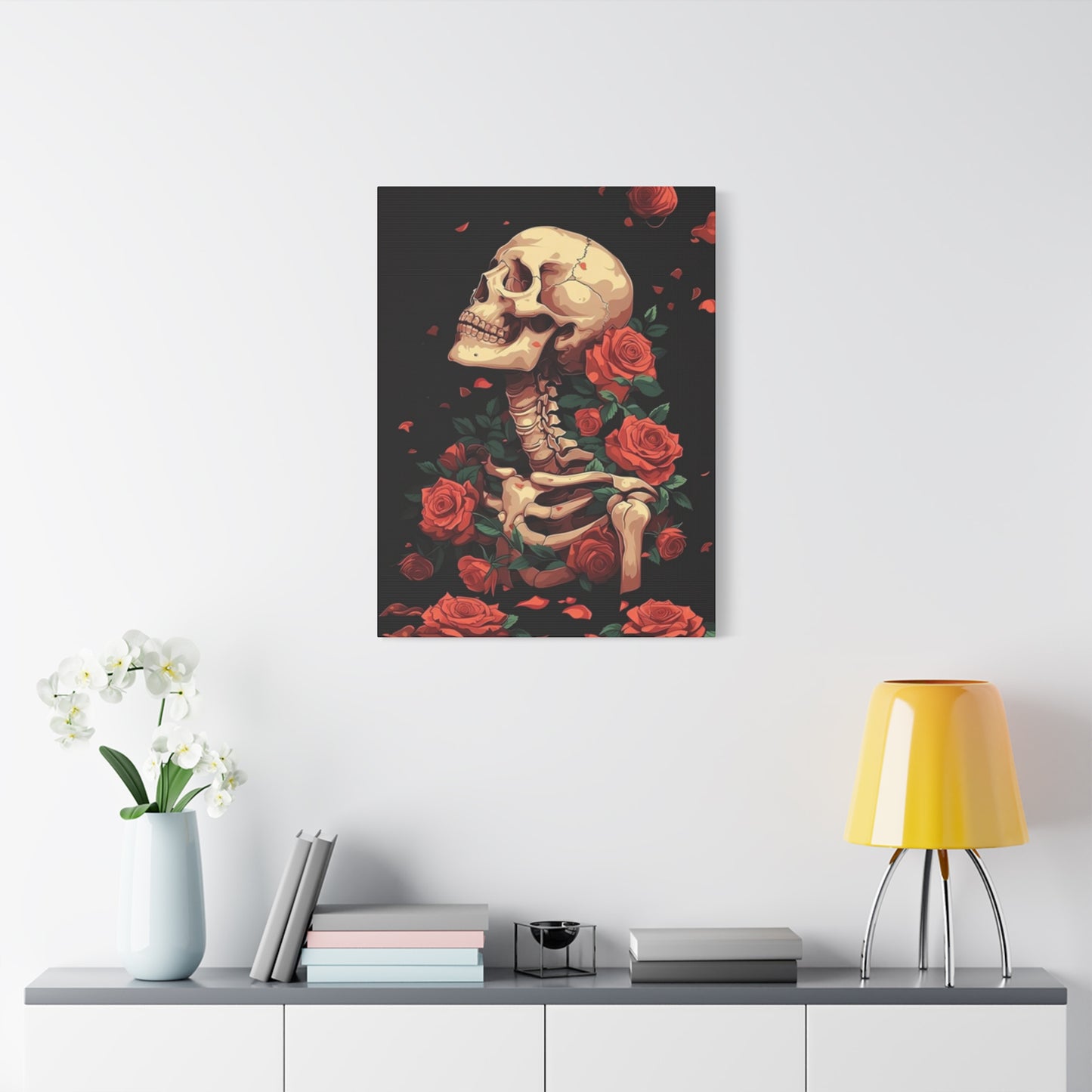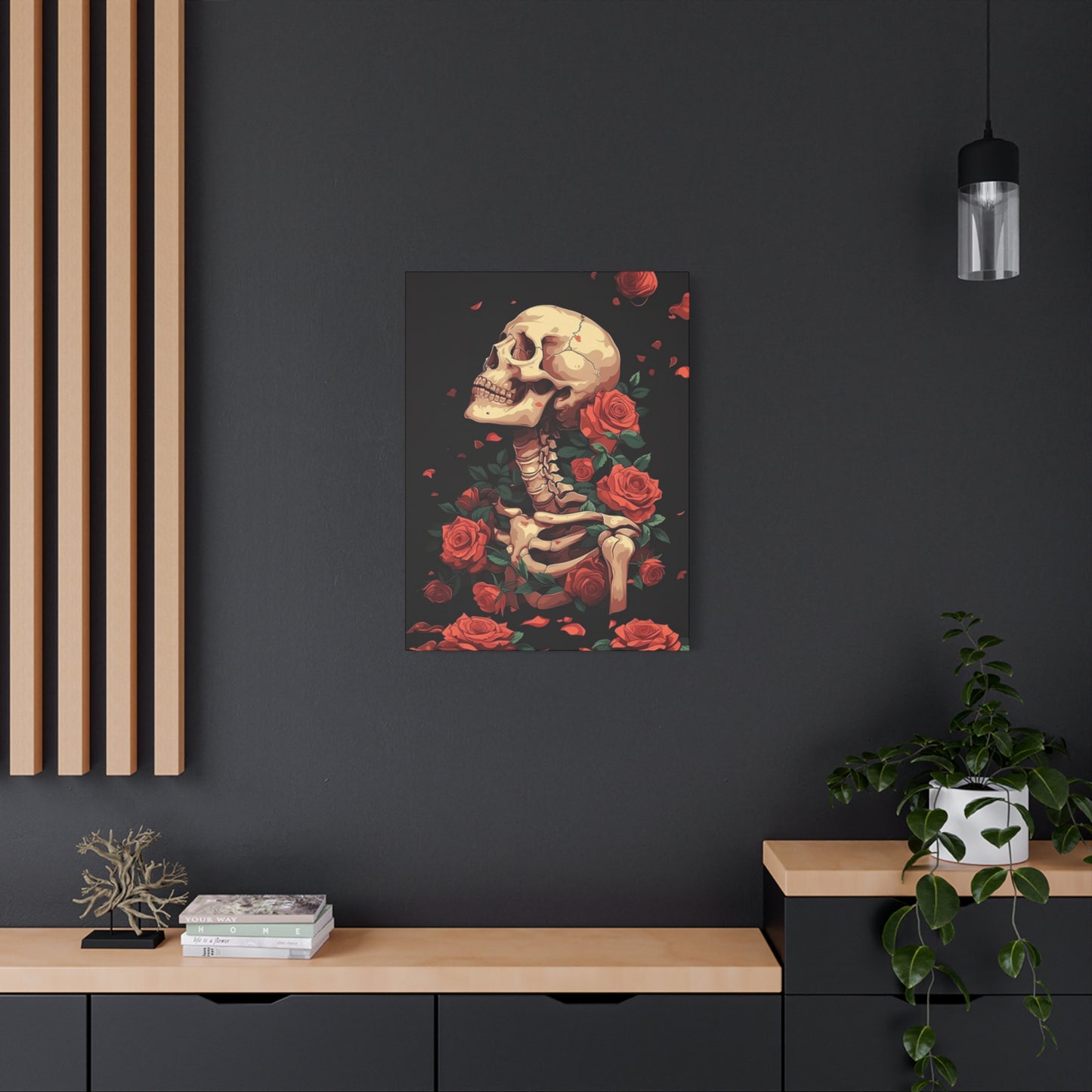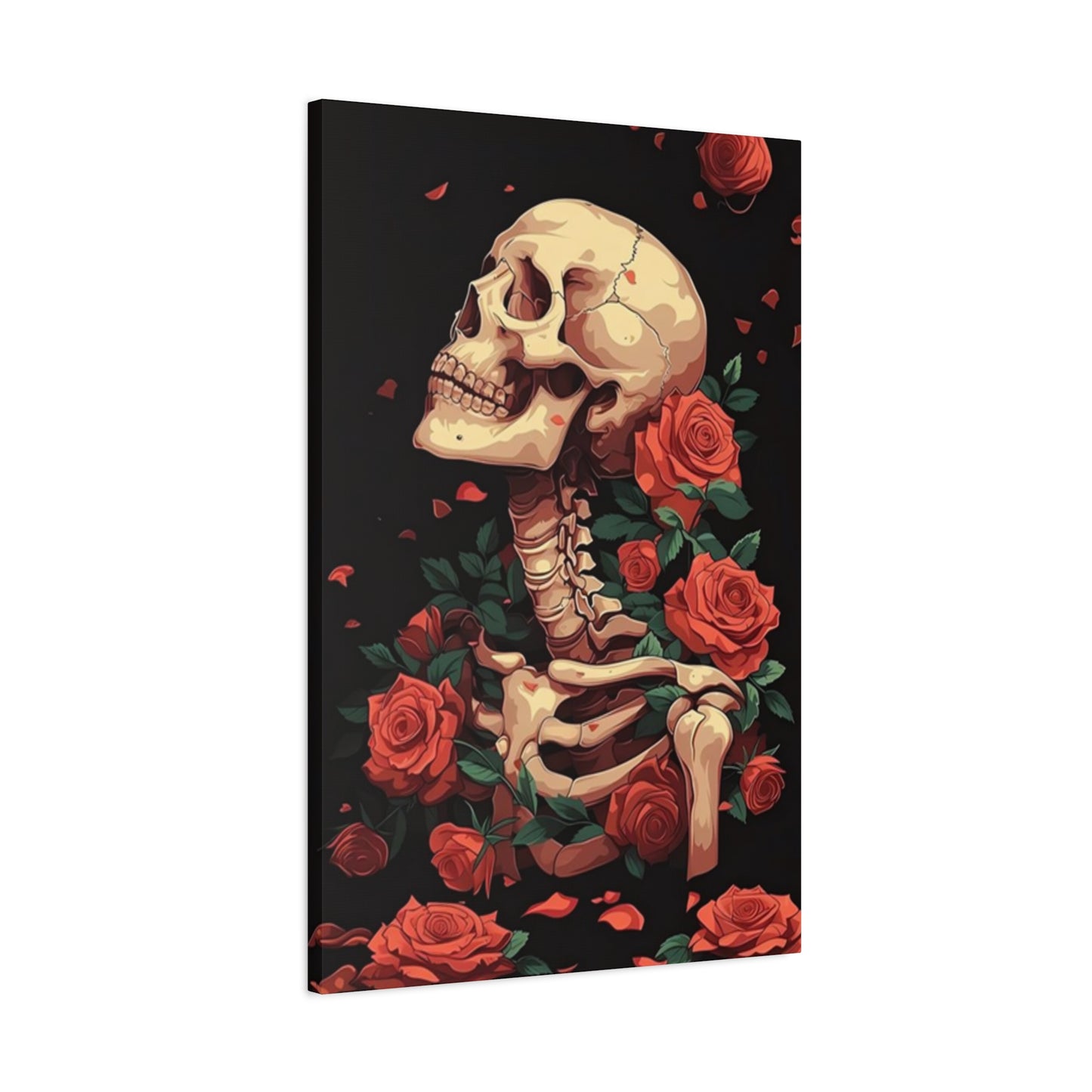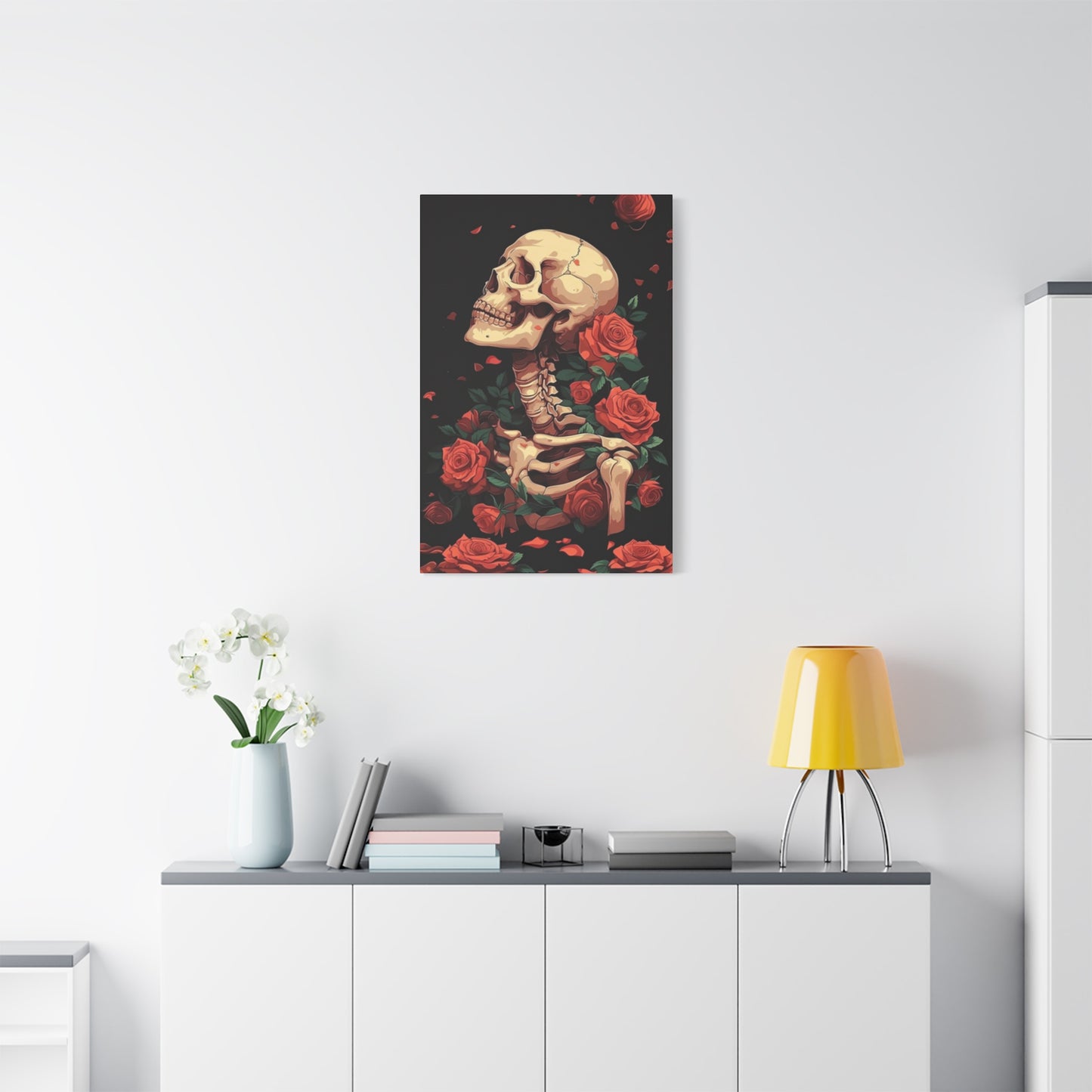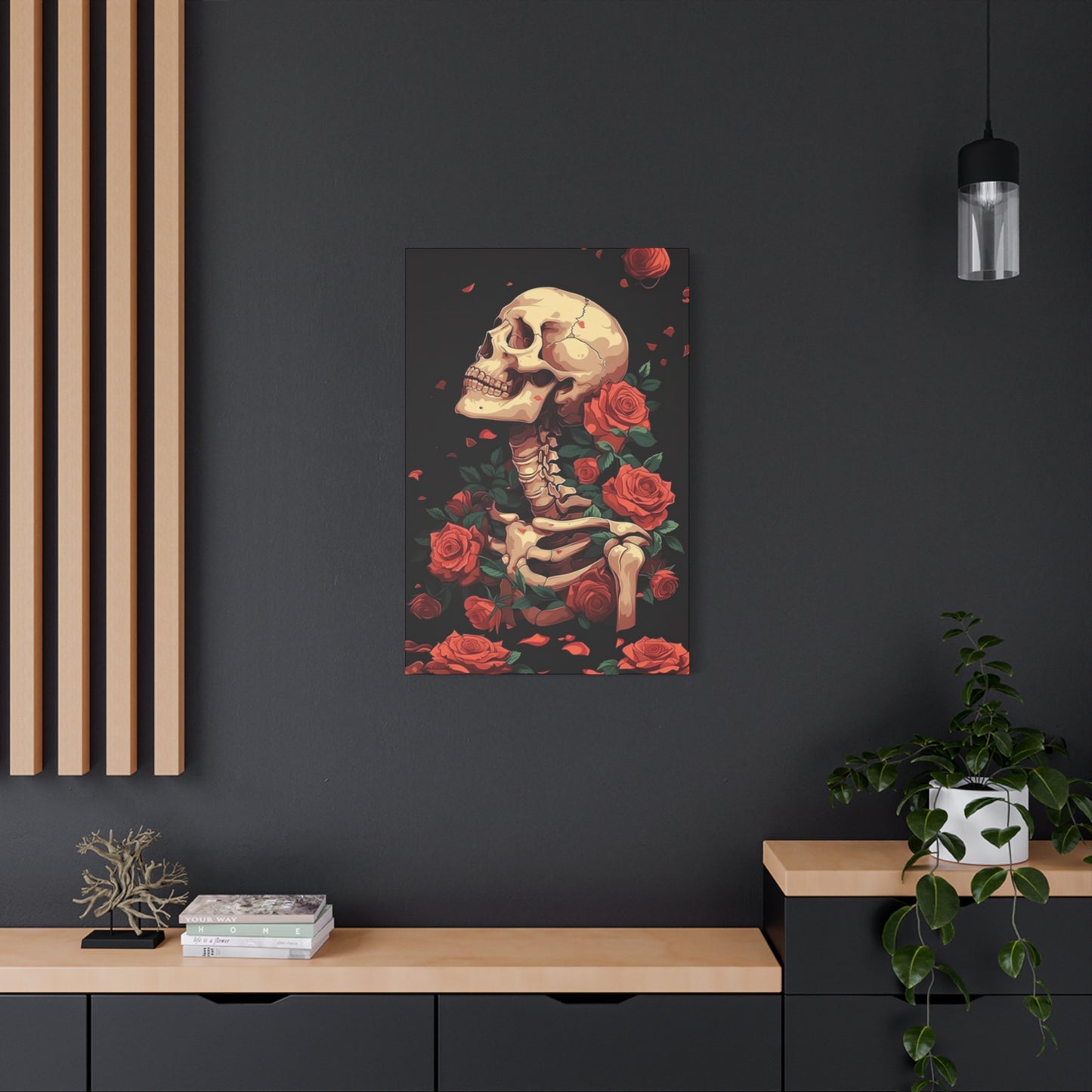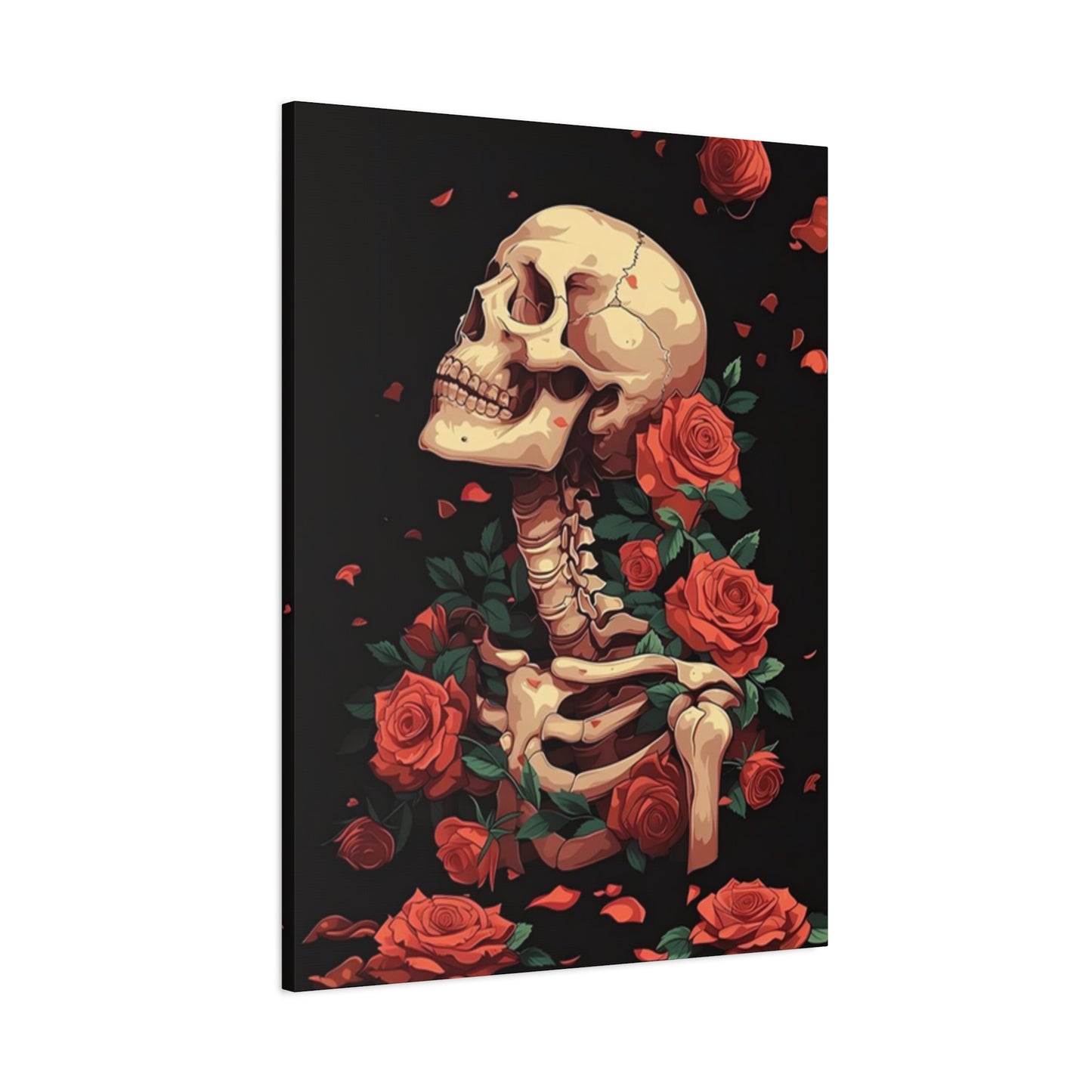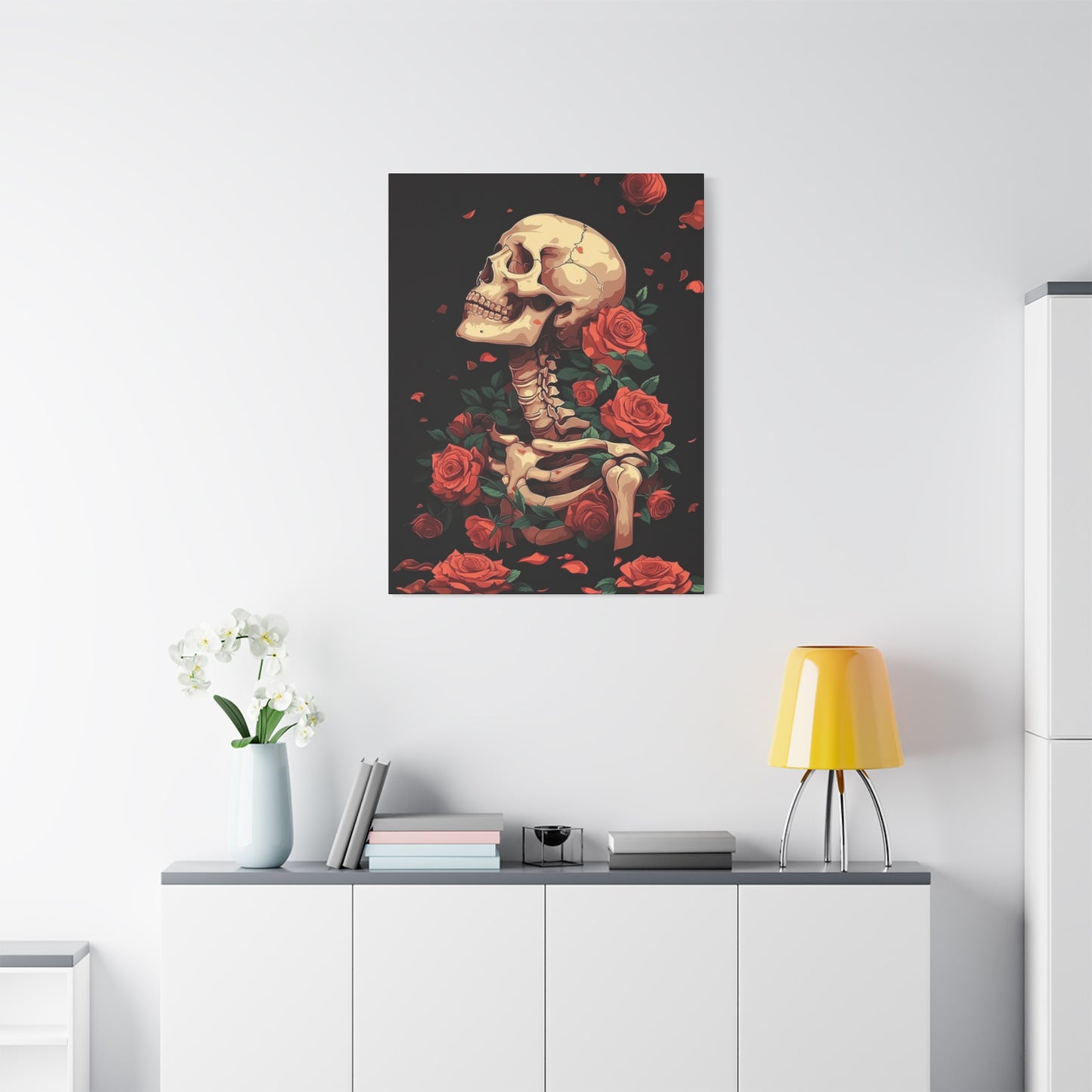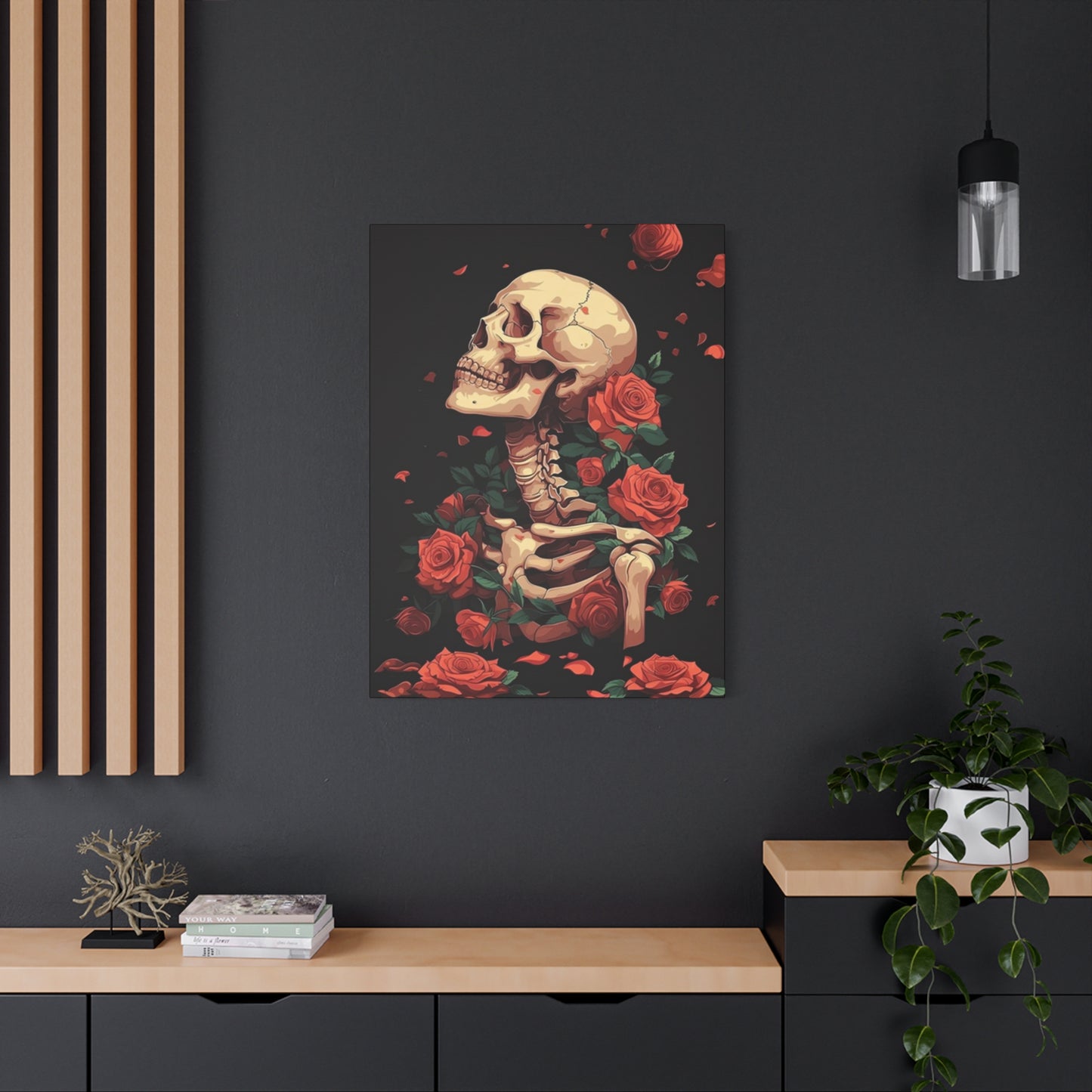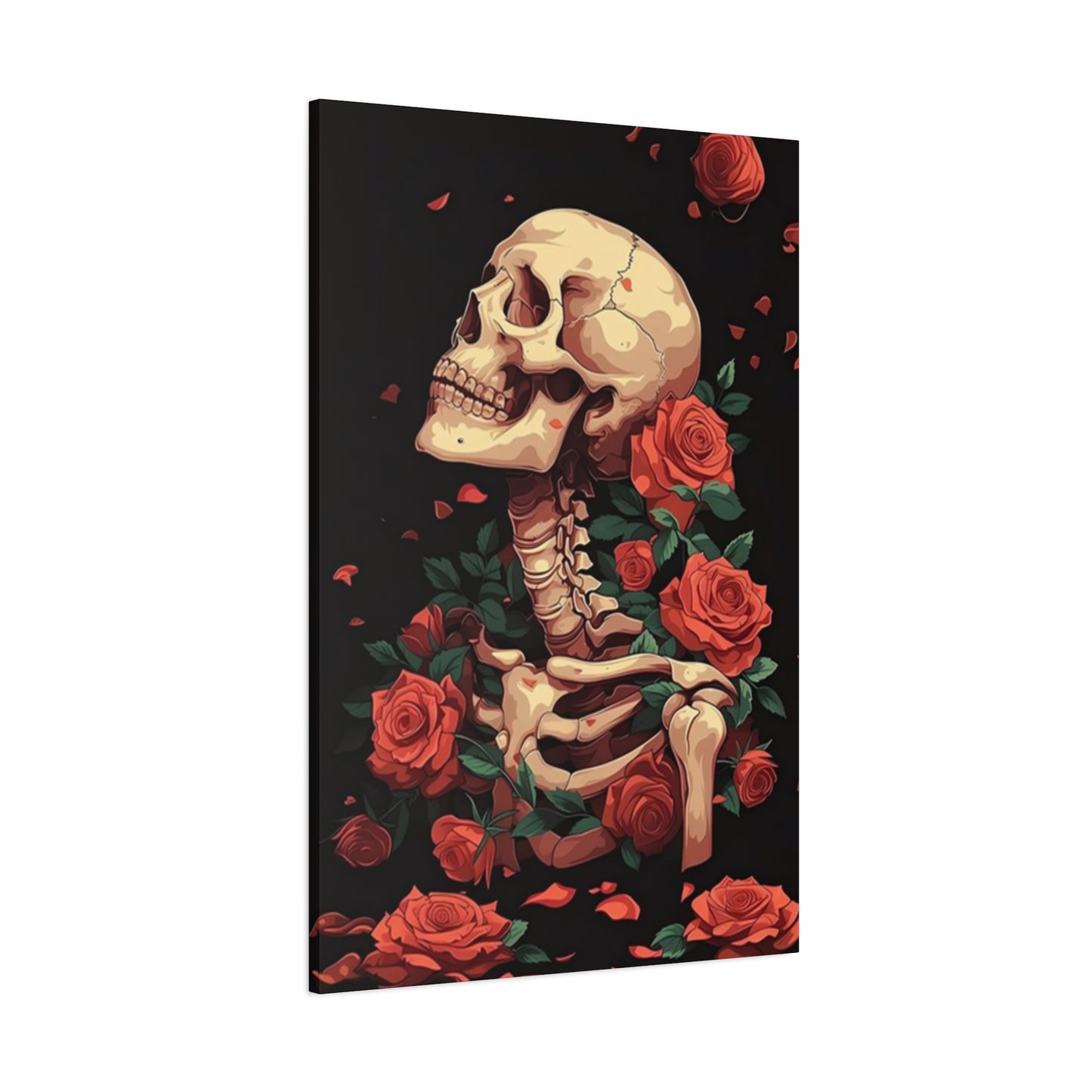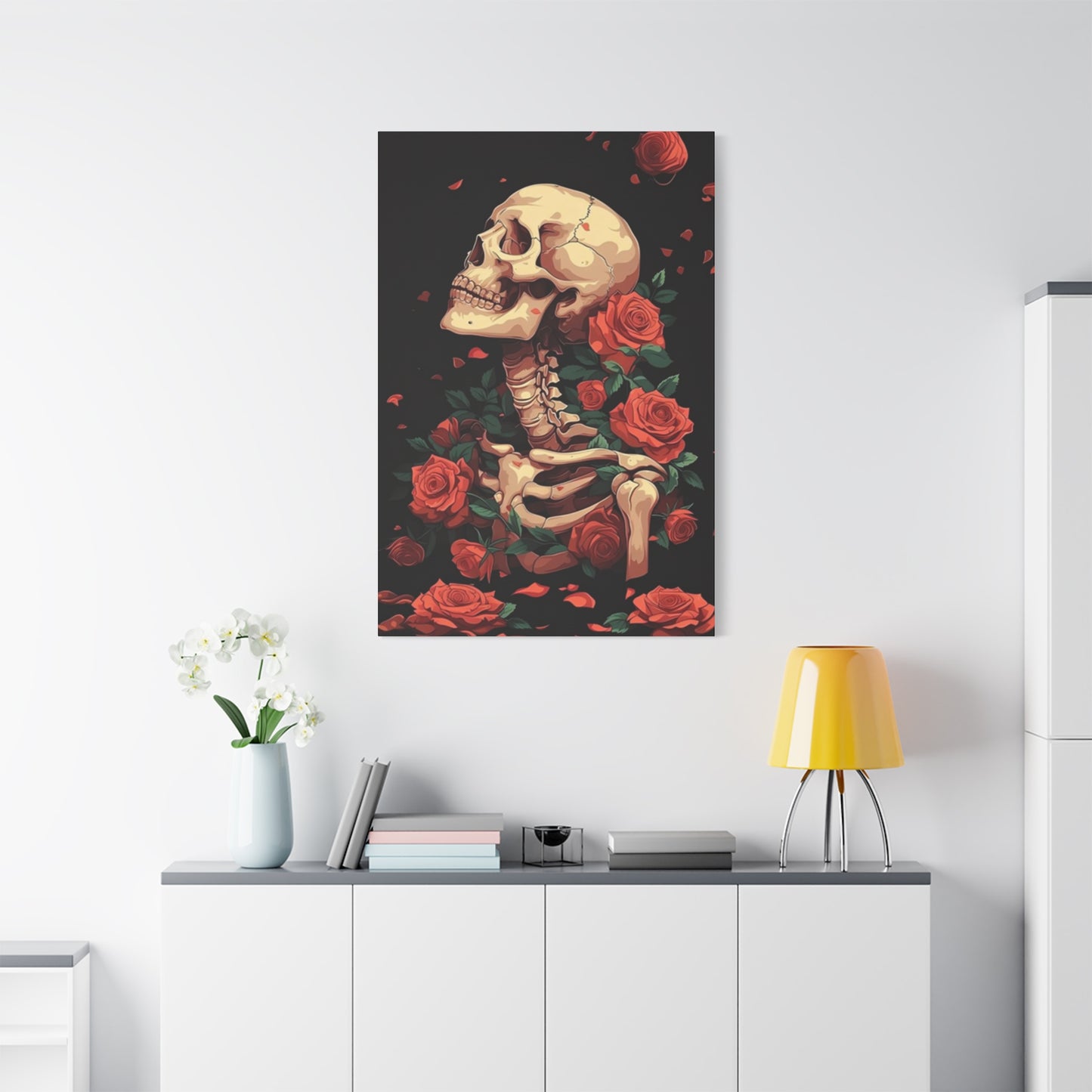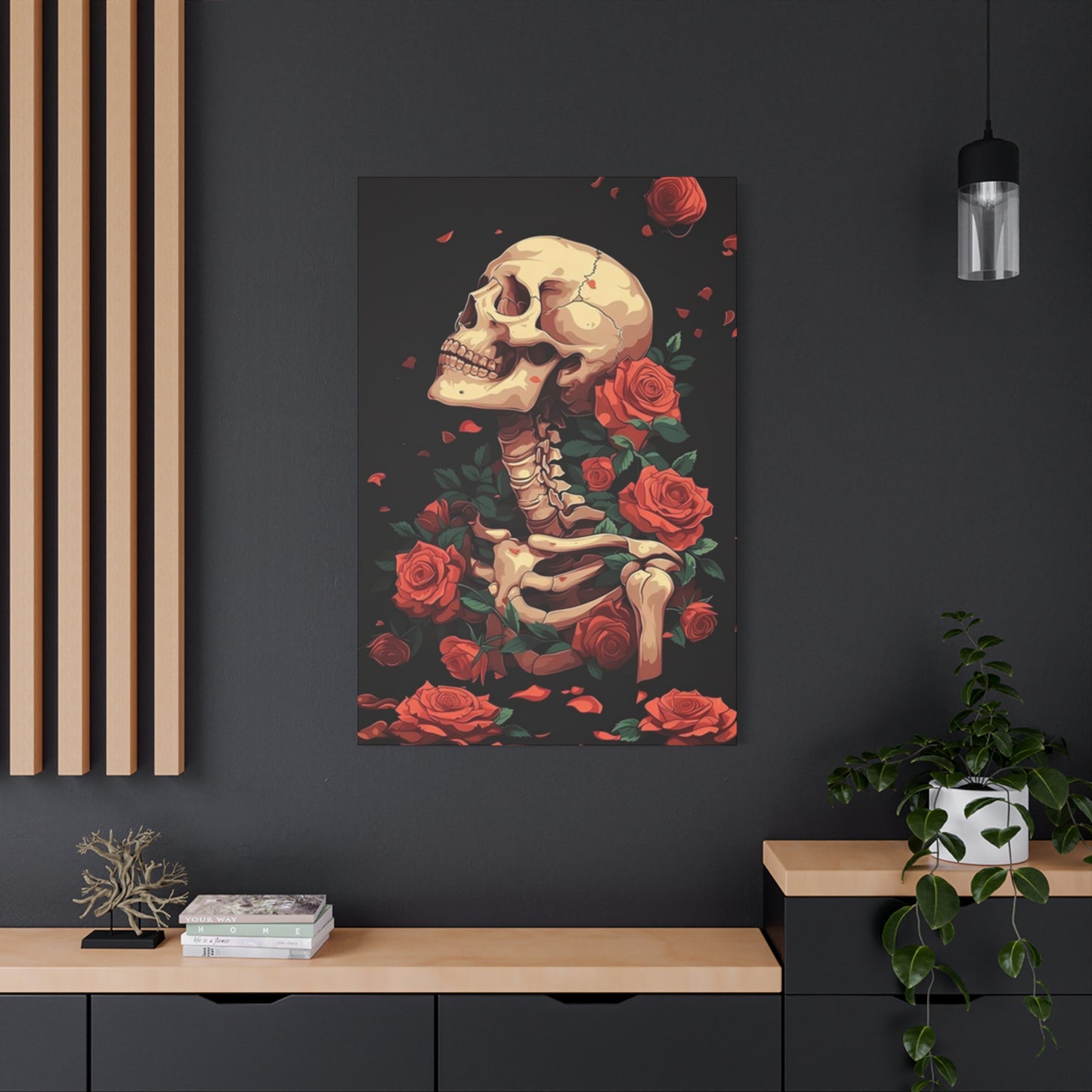Rose Skeleton Wall Art: Creating Stunning Gothic Romance in Your Home
The captivating fusion of delicate roses with haunting skeletal imagery has emerged as one of the most compelling artistic movements in contemporary home decoration. This distinctive aesthetic combines the beauty of nature with the mystery of mortality, creating powerful visual statements that resonate deeply with those who appreciate both elegance and edge. Rose skeleton wall art represents more than just decoration; it embodies a philosophical approach to living that embraces both light and shadow, beauty and impermanence.
The growing popularity of this artistic style reflects our collective fascination with duality and contrast. These pieces speak to individuals who find beauty in unconventional places and aren't afraid to display art that sparks conversation and contemplation. Whether you're drawn to the romantic aspects of blooming roses or the profound symbolism of skeletal forms, this unique artistic genre offers endless possibilities for personal expression.
Understanding the appeal of rose skeleton artwork requires appreciating its rich symbolic heritage. Throughout history, roses have represented love, passion, and beauty, while skeletal imagery has symbolized mortality, wisdom, and the passage of time. When combined, these elements create a powerful narrative about the cyclical nature of existence and the beauty that can be found in life's most profound moments.
The versatility of rose skeleton wall art makes it suitable for various decorating approaches, from subtle accents that hint at gothic sensibilities to bold statement pieces that dominate entire rooms. This adaptability has contributed to its widespread adoption across different demographic groups and decorating styles, making it one of the most accessible forms of alternative artwork available today.
Romantic Gothic Styling with Rose Skeleton Wall Art
The romantic gothic aesthetic represents a perfect marriage between the dark elegance of gothic traditions and the softer, more emotional elements of romantic design. Rose skeleton wall art serves as an ideal centerpiece for this sophisticated decorating approach, offering the visual complexity needed to create truly memorable environments. This style emphasizes the beauty found in contrast, where delicate floral elements dance alongside more mysterious skeletal forms.
Creating a romantic gothic atmosphere requires careful attention to both color palettes and lighting conditions. Deep burgundies, rich purples, and midnight blacks provide the perfect backdrop for rose skeleton artwork, while strategic lighting can enhance the dramatic impact of these pieces. Soft, warm lighting tends to emphasize the romantic aspects of the imagery, while cooler, more direct lighting can bring out the gothic elements more dramatically.
The key to successful romantic gothic styling lies in balancing opposing elements without creating visual chaos. Rose skeleton wall art naturally provides this balance, but the surrounding environment must support and enhance these qualities. Luxurious fabrics like velvet and silk can soften harder edges, while metallic accents in gold, silver, or bronze can add depth and sophistication to the overall composition.
Furniture selection plays a crucial role in supporting the romantic gothic theme. Antique or antique-inspired pieces with curved lines and ornate details complement the organic shapes found in rose imagery, while the structured elements of skeletal forms can be echoed in more geometric furniture pieces. The goal is to create a harmonious relationship between all elements in the room.
Layering different textures and materials enhances the sensual quality inherent in romantic gothic design. Combining smooth surfaces with rougher textures, matte finishes with glossy ones, and hard materials with soft fabrics creates the kind of tactile richness that makes these environments so compelling. Rose skeleton wall art often incorporates multiple textures within the artwork itself, making it an ideal focal point for this layered approach.
The emotional impact of romantic gothic styling cannot be overstated. These environments tend to evoke feelings of mystery, passion, and contemplation, making them ideal for those who appreciate depth and complexity in their living situations. The presence of rose skeleton wall art reinforces these emotional themes while providing visual anchor points that tie the entire aesthetic together.
Personal collections and meaningful objects take on special significance within romantic gothic environments. Books, candles, mirrors, and other decorative elements should be chosen for their ability to enhance the overall mood while supporting the themes present in the rose skeleton artwork. Each element should feel intentional and contribute to the narrative being created through the decorating choices.
Balancing Life and Death in Rose Skeleton Prints
The philosophical underpinnings of rose skeleton imagery provide rich opportunities for creating meaningful artistic displays that resonate on multiple levels. These pieces inherently explore the relationship between life and death, beauty and decay, permanence and impermanence, offering viewers a chance to contemplate some of life's most profound themes while enjoying stunning visual presentations.
The symbolic language of roses and skeletons has evolved over centuries, with each element carrying distinct cultural meanings that shift depending on context and presentation. Roses traditionally symbolize love, beauty, passion, and new beginnings, while skeletal imagery represents mortality, wisdom, transformation, and the eternal cycle of existence. When combined, these symbols create complex narratives that can be interpreted in numerous ways.
Contemporary artists working in this genre often explore themes of memento mori, the Latin phrase meaning "remember you must die," which served as a reminder of mortality in classical art. Modern interpretations of this concept tend to be less morbid and more celebratory, emphasizing the preciousness of life precisely because it is finite. Rose skeleton wall art often embodies this more positive interpretation, suggesting that beauty and mortality can coexist harmoniously.
The artistic treatment of these themes varies significantly depending on the artist's vision and intended message. Some pieces emphasize the delicate beauty of roses growing from or around skeletal forms, suggesting themes of renewal and regeneration. Others might focus on the gradual decay of roses alongside skeletal imagery, exploring concepts of loss and the passage of time. Still others might present both elements in perfect balance, neither dominating the composition.
Color choices play a significant role in how these themes are communicated to viewers. Vibrant, saturated colors tend to emphasize life and vitality, while muted or monochromatic palettes might lean more heavily into themes of mortality and contemplation. Many successful rose skeleton pieces use color strategically to guide viewer interpretation and emotional response.
The placement and presentation of these artworks can significantly impact their thematic resonance. Pieces displayed in bedrooms might emphasize romantic or intimate themes, while those in living areas might focus more on philosophical contemplation. The surrounding environment inevitably influences how viewers interpret the symbolic content of the artwork.
Cultural perspectives on death and mortality vary widely, and rose skeleton wall art can be appreciated differently depending on these cultural contexts. Some viewers might find comfort in the reminder of life's preciousness, while others might appreciate the aesthetic beauty without engaging deeply with the symbolic content. This flexibility makes these pieces accessible to diverse audiences.
The therapeutic potential of engaging with mortality themes through art should not be overlooked. Many people find that contemplating life and death through beautiful artistic representations helps them process their own feelings about these universal experiences. Rose skeleton wall art provides a safe and beautiful way to engage with these sometimes difficult topics.
Top Design Styles for Rose Skeleton Posters
The adaptability of rose skeleton imagery makes it compatible with numerous decorating styles, each offering unique opportunities for artistic expression and personal interpretation. Understanding how these pieces function within different design frameworks helps viewers make informed decisions about incorporation and presentation strategies.
Gothic revival styling represents perhaps the most obvious match for rose skeleton wall art, building on historical precedents while incorporating contemporary sensibilities. This approach emphasizes dramatic contrasts, rich textures, and ornate details that complement the complexity found in quality rose skeleton pieces. Dark woods, heavy fabrics, and metallic accents create environments where these artworks feel naturally at home.
Victorian gothic styling takes inspiration from the ornate decorative traditions of the 19th century while incorporating darker, more mysterious elements. Rose skeleton wall art fits beautifully into this aesthetic, particularly when paired with antique frames, rich wallpapers, and period-appropriate furniture. The romantic elements of Victorian design harmonize perfectly with the floral aspects of rose imagery.
Industrial gothic combines the raw, utilitarian elements of industrial design with gothic sensibilities, creating edgy environments where rose skeleton wall art can make powerful statements. Exposed brick, metal fixtures, and minimalist furniture provide stark backdrops that allow the intricate details of these artworks to shine while maintaining the harder edge associated with industrial aesthetics.
Bohemian gothic blends the free-spirited nature of bohemian design with darker, more mysterious elements, creating eclectic environments where rose skeleton wall art can coexist with diverse collections of objects and artwork. This style emphasizes personal expression and creative freedom, making it ideal for those who want to experiment with different presentation approaches.
Modern gothic reimagines traditional gothic elements through contemporary design principles, creating cleaner, more streamlined environments that still maintain dramatic impact. Rose skeleton wall art works beautifully in these contexts, particularly when presented in sleek, contemporary frames and paired with modern furniture and fixtures.
Romantic maximalism embraces abundance and emotional intensity, creating layered environments where rose skeleton wall art can serve as focal points within larger collections of meaningful objects. This approach allows for creative mixing of different artistic styles and periods while maintaining coherent emotional themes throughout the environment.
Minimalist gothic strips away unnecessary elements while maintaining the essential dramatic impact of gothic design. In these contexts, rose skeleton wall art often serves as the primary source of visual interest, making careful selection and presentation absolutely crucial to the success of the overall design scheme.
Dark academia styling incorporates scholarly and literary themes with gothic sensibilities, creating environments that feel both intellectual and mysterious. Rose skeleton wall art fits naturally into this aesthetic, particularly when paired with books, vintage globes, antique writing implements, and other objects associated with learning and contemplation.
Cottagecore gothic combines the cozy, nature-inspired elements of cottagecore with darker, more mysterious themes, creating unique environments where rose skeleton wall art can bridge the gap between natural beauty and gothic drama. This emerging style offers exciting possibilities for creative interpretation and personal expression.
Using Skeleton and Rose Art in Minimalist Settings
The challenge of incorporating rose skeleton wall art into minimalist environments requires careful consideration of scale, placement, and supporting elements. While minimalist design principles emphasize simplicity and restraint, the inherent complexity of rose skeleton imagery can create stunning focal points that enhance rather than overwhelm these carefully curated environments.
The key to successful minimalist integration lies in treating rose skeleton wall art as the primary source of visual interest within the room. This approach requires selecting pieces with exceptional artistic quality and emotional resonance, since they will likely be the main decorative element in the environment. Every aspect of the artwork becomes crucial, from composition and color palette to framing and positioning.
Scale considerations become particularly important in minimalist contexts. Larger pieces can dominate minimalist environments in ways that might feel overwhelming, while pieces that are too small might get lost against expansive blank walls. Finding the right balance requires careful attention to room proportions and the relationship between the artwork and surrounding architectural elements.
Color coordination takes on special significance when working with minimalist principles. Rose skeleton wall art with limited color palettes tends to integrate more easily into minimalist environments, while pieces with complex or vibrant color schemes might require more careful consideration. Monochromatic or near-monochromatic pieces often work particularly well in these contexts.
The quality of framing becomes especially important in minimalist settings, where every element receives more visual attention. Simple, clean frames that don't compete with the artwork itself tend to work best, though the material and finish should complement both the artwork and the overall aesthetic of the room. Sometimes, going frameless can create even cleaner integration.
Lighting strategies require special attention in minimalist environments featuring rose skeleton wall art. The absence of visual clutter means that lighting effects become more pronounced and noticeable. Strategic illumination can dramatically enhance the impact of the artwork while maintaining the clean, uncluttered feeling essential to minimalist design.
Supporting elements should be chosen very carefully, with each additional object serving a specific purpose and contributing positively to the overall composition. In minimalist contexts, every decorative choice matters more, so any supporting elements should enhance rather than detract from the rose skeleton wall art.
The psychological impact of combining minimalist principles with rose skeleton imagery can be quite powerful. The contrast between the simplicity of the environment and the complexity of the artwork creates a dynamic tension that can make both elements more impactful. This approach can create spaces that feel both calming and stimulating.
Maintenance considerations become more important in minimalist environments, where dust and wear are more noticeable. Rose skeleton wall art in these contexts should be easily cleanable and positioned where it won't accumulate dust or suffer damage from daily activities.
The flexibility of minimalist approaches allows for seasonal or periodic changes in artwork display, making it possible to rotate different rose skeleton pieces based on mood, season, or personal preference. This approach keeps minimalist environments feeling fresh while maintaining their essential simplicity.
Rose Skeleton Wall Art for Dark, Elegant Environments
Creating dark, elegant environments provides ideal settings for showcasing the dramatic beauty of rose skeleton wall art. These sophisticated decorating approaches emphasize luxury, mystery, and emotional depth, creating environments where complex artistic themes can be fully appreciated and explored.
The foundation of dark elegance lies in carefully selected color palettes that emphasize depth and richness over brightness and contrast. Deep blues, rich burgundies, forest greens, and various shades of black and gray create the perfect backdrop for rose skeleton artwork, allowing both the floral and skeletal elements to shine without competing with overwhelming background colors.
Lighting strategies become crucial in dark elegant environments, where the interplay between light and shadow can dramatically enhance the mood and impact of rose skeleton wall art. Layered lighting approaches using table lamps, floor lamps, and accent lighting can create sophisticated illumination schemes that highlight artwork while maintaining the intimate, mysterious atmosphere essential to this decorating style.
Texture plays an increasingly important role in dark environments, where visual interest must be maintained despite limited color variation. Incorporating various textures through fabrics, wall treatments, and decorative objects adds depth and sophistication while complementing the textural elements often found in quality rose skeleton artwork.
Furniture selection should emphasize quality over quantity, with each piece chosen for its ability to contribute to the overall atmosphere while providing necessary functionality. Antique and vintage pieces often work particularly well in dark elegant environments, their historical character complementing the timeless themes explored in rose skeleton imagery.
Material choices throughout the environment should emphasize luxury and permanence. Rich woods, quality metals, natural stone, and high-end fabrics create the kind of sophisticated backdrop that allows rose skeleton wall art to be fully appreciated. These materials also tend to age beautifully, supporting the themes of time and permanence often explored in this artistic genre.
The arrangement of furniture and decorative objects should create intimate conversation areas where the artwork can be properly contemplated and discussed. Dark elegant environments work best when they facilitate close interaction with the art and meaningful conversation among viewers.
Personal collections take on special significance in dark elegant environments, where carefully curated objects can enhance and support the themes present in rose skeleton wall art. Books, sculptures, vintage photographs, and other meaningful items should be chosen for their ability to contribute to the overall narrative being created through the decorating choices.
The emotional impact of dark elegant environments enhanced by rose skeleton wall art tends to be profound and lasting. These settings encourage contemplation, meaningful conversation, and deep aesthetic appreciation, making them ideal for those who view their homes as sanctuaries for reflection and artistic appreciation.
Tattoo-Inspired Rose and Skeleton Poster Ideas
The relationship between tattoo artistry and wall art has grown increasingly close as both mediums explore similar themes and aesthetic approaches. Rose skeleton wall art draws heavily from tattoo traditions, incorporating bold lines, dramatic contrasts, and symbolic imagery that translates beautifully from skin to wall display.
Traditional American tattoo styling emphasizes bold outlines, limited color palettes, and iconic imagery that remains readable and impactful over time. Rose skeleton wall art inspired by these traditions tends to feature strong graphic elements, clear symbolic content, and compositions that maintain their visual impact from various viewing distances.
Neo-traditional tattoo approaches blend classical tattoo imagery with more contemporary artistic techniques, allowing for greater detail, more complex color work, and more sophisticated compositional arrangements. Rose skeleton wall art in this style often features more realistic rendering of both floral and skeletal elements while maintaining the bold, graphic quality associated with tattoo artistry.
Blackwork tattoo traditions emphasize the power of black ink alone to create dramatic, impactful imagery. Rose skeleton wall art inspired by blackwork often features stark contrasts between black and white elements, with careful attention to negative space and bold graphic composition. These pieces can be particularly effective in minimalist or high-contrast environments.
Watercolor tattoo techniques have influenced contemporary rose skeleton wall art through their emphasis on flowing, organic color application and softer, more painterly approaches to traditional tattoo imagery. These pieces often feature beautiful color bleeding effects and more naturalistic representations of both roses and skeletal forms.
Realistic tattoo styling has pushed the boundaries of what's possible in both tattoo and wall art mediums. Rose skeleton pieces inspired by photorealistic tattoo work often feature incredible detail and dimensional quality that can create stunning focal points in home environments.
Geometric tattoo approaches incorporate mathematical patterns and geometric shapes into traditional imagery, creating rose skeleton wall art that combines organic and geometric elements in sophisticated ways. These pieces often appeal to viewers who appreciate both natural beauty and mathematical precision.
Biomechanical tattoo styling blends organic and mechanical elements, creating rose skeleton wall art that might incorporate gears, pistons, or other mechanical components alongside traditional floral and skeletal imagery. This approach can create particularly striking pieces that appeal to viewers interested in steampunk or industrial aesthetics.
Cultural tattoo traditions from around the world have influenced rose skeleton wall art through their unique approaches to symbolism, composition, and artistic technique. Japanese, Polynesian, Celtic, and other cultural influences can be seen in contemporary rose skeleton pieces that incorporate traditional design elements from these various artistic traditions.
The scale considerations that apply to tattoo design also influence wall art presentation. Pieces that work effectively as tattoos often translate well to smaller wall art formats, while larger wall pieces might require different compositional approaches to maintain their visual impact and symbolic clarity.
How to Frame and Display Rose Skeleton Prints
The presentation of rose skeleton wall art significantly impacts its visual effectiveness and thematic resonance. Proper framing and display techniques can enhance the artistic qualities of these pieces while ensuring they integrate successfully into various decorating schemes and environmental contexts.
Frame selection should complement rather than compete with the artwork itself. Rose skeleton pieces often feature complex compositions with multiple focal points, making it important to choose frames that provide support without adding unnecessary visual complexity. Simple, clean frames often work best, though ornate frames can be appropriate in certain decorating contexts.
Material considerations for framing include wood, metal, and composite materials, each offering different aesthetic qualities and practical benefits. Wood frames can add warmth and natural texture that complements the organic elements in rose imagery, while metal frames might emphasize the harder, more structural aspects of skeletal forms. The choice should reflect both personal preference and the intended decorating context.
Color coordination between frame and artwork requires careful attention to ensure harmonious integration. Neutral frame colors like black, white, or natural wood tones tend to work well with most rose skeleton pieces, while colored frames should be chosen to enhance specific color elements within the artwork without overwhelming the composition.
Matting decisions can significantly impact the visual presentation of rose skeleton prints. Wide mats can create breathing room around complex compositions, while narrow mats or no mats at all might be appropriate for pieces with simpler compositions or when display area is limited. The color and texture of matting material should complement both the artwork and the frame.
Glass selection involves choosing between regular glass, non-reflective glass, or acrylic alternatives. Non-reflective options tend to work better for pieces that will be viewed under various lighting conditions, while regular glass might be sufficient for pieces in consistently controlled lighting environments. UV protection becomes important for pieces that will be exposed to direct or indirect sunlight.
Placement considerations include height, lighting, and relationship to other elements in the room. Rose skeleton wall art generally works best at eye level for typical viewing, though larger pieces might be positioned slightly higher. The relationship to furniture, doorways, windows, and other architectural elements should be carefully considered.
Lighting strategies can dramatically enhance the impact of properly framed rose skeleton prints. Direct lighting can highlight fine details and create dramatic shadow effects, while indirect lighting might emphasize mood and atmosphere. The quality and color temperature of lighting should complement the emotional tone of the artwork.
Grouping strategies allow for creative presentation of multiple rose skeleton pieces together. Symmetrical arrangements can create formal, balanced presentations, while asymmetrical groupings might feel more dynamic and contemporary. The spacing between pieces should allow each artwork to be appreciated individually while contributing to the overall composition.
Protection considerations include positioning artwork away from direct sunlight, humidity sources, and high-traffic areas where damage might occur. Proper hanging hardware should be selected based on the weight of the framed piece and the wall material where it will be displayed.
Color Themes in Rose Skeleton Wall Art
The strategic use of color in rose skeleton wall art creates powerful emotional and aesthetic effects that can dramatically influence how these pieces are perceived and integrated into home environments. Understanding color theory and its application to this distinctive artistic genre helps viewers make informed decisions about selection and presentation.
Monochromatic color schemes using various shades of a single color can create sophisticated, cohesive presentations that emphasize form and composition over color contrast. Rose skeleton pieces executed in monochromatic palettes often feel more contemplative and refined, making them suitable for environments where subtle elegance is preferred over dramatic impact.
Complementary color relationships, such as red roses with green skeletal elements or purple roses with yellow accents, create dynamic visual tension that can make rose skeleton wall art feel more energetic and engaging. These high-contrast combinations tend to work well in environments where the artwork serves as a primary focal point.
Analogous color schemes using colors that are adjacent on the color wheel, such as reds, oranges, and yellows, create harmonious presentations that feel warm and inviting while maintaining visual interest. Rose skeleton pieces using analogous color schemes often integrate more easily into existing decorating schemes.
Triadic color relationships using three colors equally spaced around the color wheel can create vibrant, balanced compositions that feel both dynamic and harmonious. Rose skeleton wall art using triadic color schemes tends to work best in environments that can support more complex color relationships.
Warm color palettes emphasizing reds, oranges, and yellows can make rose skeleton wall art feel more passionate, energetic, and emotionally engaging. These pieces often work well in social environments where the goal is to create welcoming, stimulating atmospheres.
Cool color palettes using blues, greens, and purples can make rose skeleton wall art feel more mysterious, contemplative, and sophisticated. These pieces often work well in private environments like bedrooms or studies where the goal is to create calming, reflective atmospheres.
Neutral color approaches using blacks, whites, grays, and earth tones can make rose skeleton wall art feel more timeless and versatile. These pieces tend to integrate easily into various decorating schemes and can serve as long-term investments that won't become dated as color trends change.
Metallic accents in gold, silver, copper, or bronze can add luxury and sophistication to rose skeleton wall art while creating interesting textural contrasts. These elements often work particularly well in dark elegant environments where they can catch and reflect available light.
Color symbolism plays an important role in how rose skeleton wall art is interpreted by viewers. Red roses might emphasize passion and love, while black roses could suggest mystery or loss. Understanding these symbolic associations can help viewers choose pieces that resonate with their intended emotional themes.
The relationship between artwork colors and environmental colors significantly impacts overall aesthetic success. Rose skeleton pieces should either harmonize with existing room colors or provide intentional contrast that enhances rather than conflicts with the decorating scheme.
Best Rooms to Hang Rose Skeleton Posters
The selection of appropriate rooms for displaying rose skeleton wall art requires careful consideration of both practical and aesthetic factors. Different rooms offer unique opportunities for artistic expression while presenting specific challenges that must be addressed for successful integration.
Living rooms provide excellent opportunities for showcasing rose skeleton wall art as focal points for social interaction and aesthetic appreciation. These environments typically offer adequate wall area, controlled lighting conditions, and regular viewing opportunities that allow the artwork to be fully appreciated. The conversational potential of rose skeleton imagery makes it particularly suitable for social environments.
Bedrooms offer intimate settings where rose skeleton wall art can create personal sanctuaries that reflect individual tastes and philosophical perspectives. The private nature of bedroom environments allows for more experimental or provocative artistic choices that might not be appropriate in more public areas of the home.
Dining rooms can provide sophisticated settings for rose skeleton wall art that enhances the social and cultural aspects of shared meals. The contemplative themes often explored in this artistic genre can contribute to meaningful dinner conversation while creating memorable experiences for guests.
Home offices and studies offer opportunities to display rose skeleton wall art in environments associated with thought, contemplation, and intellectual pursuits. The symbolic depth of these pieces can provide inspiration and focal points for reflection during work or study sessions.
Hallways and entryways can use rose skeleton wall art to create dramatic first impressions and establish the aesthetic tone for the entire home. These transitional areas often benefit from artwork that makes strong visual statements without requiring extended contemplation.
Bathrooms, while less conventional, can provide interesting opportunities for displaying rose skeleton wall art in environments associated with personal care and private reflection. The themes of transformation and renewal often explored in this artistic genre can resonate particularly well in these intimate settings.
Kitchen environments might incorporate rose skeleton wall art in ways that celebrate the cyclical nature of nourishment and sustenance. The life and death themes present in this imagery can connect meaningfully with food preparation and consumption activities.
Guest rooms can use rose skeleton wall art to create memorable experiences for visitors while expressing the homeowner's aesthetic preferences. These environments often benefit from artwork that sparks conversation and provides insight into the host's personality and interests.
Exercise or meditation rooms can incorporate rose skeleton wall art in ways that support contemplative practices and physical wellness activities. The philosophical themes present in this imagery can enhance the reflective aspects of these activities.
Library or reading areas can use rose skeleton wall art to create atmospheric environments that support intellectual pursuits and literary appreciation. The symbolic richness of these pieces can complement the thoughtful nature of reading and study activities.
DIY Rose Skeleton Wall Art for Creative Souls
Creating original rose skeleton wall art provides opportunities for personal expression and artistic exploration while ensuring completely unique pieces that perfectly match individual aesthetic preferences and decorating needs. Various DIY approaches accommodate different skill levels and artistic interests.
Drawing and illustration techniques offer the most direct approach to creating original rose skeleton wall art. Basic drawing skills can be developed through practice and online tutorials, while more advanced techniques like shading, perspective, and composition can be learned through dedicated study. Digital drawing tools and software provide additional possibilities for creating professional-quality artwork.
Mixed media approaches combine traditional drawing or painting with other materials like fabric, metal, or found objects to create dimensional rose skeleton wall art with unique textural qualities. These techniques allow for experimentation with different materials and can result in truly one-of-a-kind pieces.
Photography-based approaches might involve creating still life compositions using real roses and decorative skulls or skeletal models, then manipulating the images through digital editing to achieve desired artistic effects. This approach can create striking realistic imagery while allowing for creative interpretation.
Printmaking techniques like linocut, woodcut, or screen printing can produce rose skeleton wall art with distinctive textural qualities and bold graphic impact. These traditional artistic techniques have experienced renewed interest among contemporary artists and hobbyists.
Digital art creation using software like Photoshop, Illustrator, or free alternatives like GIMP provides powerful tools for creating sophisticated rose skeleton wall art. These digital approaches allow for easy experimentation with color, composition, and effects while producing artwork suitable for high-quality printing.
Collage techniques using magazine cutouts, photographs, or other printed materials can create unique rose skeleton compositions with interesting layered effects. This approach requires minimal artistic training while allowing for creative exploration of color, texture, and composition.
Stenciling approaches can create clean, graphic rose skeleton wall art suitable for various decorating applications. Custom stencils can be cut by hand or created using digital cutting machines, then used with paints, markers, or other coloring media.
Transfer techniques allow for reproducing existing rose skeleton images onto various surfaces using methods like gel medium transfers or heat transfers. These approaches can create interesting artistic effects while providing access to high-quality imagery.
Embroidery and textile arts can create rose skeleton wall art with distinctive textural qualities and handmade character. These traditional crafts have been embraced by contemporary artists interested in exploring the intersection between fine art and functional crafts.
Three-dimensional approaches might involve creating sculptural rose skeleton wall art using materials like clay, metal, wood, or found objects. These techniques can create striking pieces with dramatic shadow effects and tactile qualities that distinguish them from traditional flat artwork.
The Emotional Power of Skeleton and Rose Imagery
The psychological and emotional impact of rose skeleton wall art extends far beyond mere aesthetic appreciation, tapping into fundamental human experiences and archetypal imagery that resonates across cultural and personal boundaries. Understanding these deeper meanings can enhance both selection and appreciation of these powerful artistic expressions.
The juxtaposition of life and death symbolized by roses and skeletons creates cognitive tension that engages viewers on multiple levels simultaneously. This contrast forces contemplation of fundamental existential questions while providing beautiful imagery that makes these sometimes difficult topics more approachable and less threatening.
Memento mori traditions in art have historically served to remind viewers of mortality while encouraging appreciation for life's precious and temporary nature. Contemporary rose skeleton wall art continues this tradition in forms that feel relevant and accessible to modern audiences, providing gentle reminders about priorities and perspective.
The romantic associations of roses combined with the mortality themes of skeletal imagery create complex emotional narratives that can resonate with viewers experiencing various life transitions. These pieces might provide comfort during times of loss while celebrating the beauty and intensity of life and love.
Psychological research suggests that engaging with mortality themes through art can increase appreciation for life, strengthen relationships, and clarify personal values. Rose skeleton wall art provides a beautiful and non-threatening way to engage with these important psychological processes.
The archetypal nature of both floral and skeletal imagery connects with deep psychological patterns that transcend individual experience. These universal symbols speak to shared human experiences while allowing for highly personal interpretation and meaning-making.
Color psychology plays a significant role in how rose skeleton wall art affects viewers emotionally. Warm colors might emphasize passion and vitality, while cooler colors could promote contemplation and introspection. Understanding these relationships can help viewers choose pieces that support their desired emotional experiences.
The therapeutic potential of contemplating beautiful representations of life and death themes should not be overlooked. Many viewers find that these artworks help them process their own feelings about loss, change, and the passage of time in healthy and constructive ways.
Cultural perspectives on death and mortality vary significantly, and rose skeleton wall art can be interpreted differently depending on these cultural contexts. Some viewers might emphasize celebration of life, while others might focus more heavily on themes of loss and remembrance.
The social aspects of displaying rose skeleton wall art can create opportunities for meaningful conversations about philosophy, spirituality, and personal values. These pieces often serve as conversation starters that can deepen relationships and understanding among viewers.
Personal resonance with rose skeleton imagery often develops over time as viewers' life experiences provide new contexts for interpretation. Pieces that initially appeal for aesthetic reasons might develop deeper meaning as viewers encounter various life challenges and transitions.
Vintage vs Modern Rose Skeleton Art Styles
The evolution of rose skeleton imagery reflects broader changes in artistic techniques, cultural attitudes, and aesthetic preferences, creating distinct stylistic categories that appeal to different tastes and decorating approaches. Understanding these differences helps viewers make informed choices about style and presentation.
Victorian and early 20th-century approaches to mortality themes in art tend to be more formal, symbolic, and heavily coded in their presentation. Historical rose skeleton imagery often incorporates elaborate decorative elements, religious symbolism, and classical compositional approaches that reflect the artistic conventions of their periods.
Art Nouveau influences can be seen in rose skeleton pieces that emphasize flowing, organic lines and decorative integration between floral and skeletal elements. These pieces often feature sophisticated compositional approaches that blend naturalistic and stylized elements in harmonious relationships.
Art Deco styling brings geometric precision and bold graphic elements to rose skeleton imagery, creating pieces that feel more streamlined and modern while maintaining the essential symbolic content. These approaches often work well in contemporary environments that appreciate both historical reference and modern sensibilities.
Mid-century modern approaches to rose skeleton themes tend to emphasize simplified forms, bold color relationships, and clean compositional approaches that reflect the design principles of that era. These pieces often feel more optimistic and less gothic than their historical predecessors.
Contemporary realistic approaches use modern artistic techniques to create highly detailed, photographic rose skeleton imagery that can be startlingly lifelike. These pieces often appeal to viewers who appreciate technical skill and realistic representation in their artwork.
Abstract and expressionist interpretations of rose skeleton themes focus more on emotional content and artistic interpretation than literal representation. These approaches can create powerful pieces that convey the essential themes while allowing for more personal and subjective interpretation.
Digital art techniques have opened new possibilities for rose skeleton imagery, allowing for effects and presentations that would be impossible with traditional media. These contemporary approaches can create pieces with unique visual qualities that feel distinctly modern and cutting-edge.
Street art and graffiti influences have brought rose skeleton imagery into more urban and edgy artistic contexts, often incorporating bold graphics, spray paint techniques, and contemporary cultural references that appeal to younger audiences.
Pop art approaches to rose skeleton themes might incorporate commercial imagery, bright colors, and repetitive elements that comment on contemporary culture while maintaining the essential symbolic content. These pieces can feel both familiar and subversive.
Neo-gothic revival movements in contemporary art have brought new sophistication to traditional gothic themes, creating rose skeleton pieces that honor historical precedents while incorporating contemporary artistic sensibilities and techniques.
Mixing Floral and Anatomical Art in Home Decoration
The integration of rose skeleton wall art into broader decorating schemes that incorporate both botanical and anatomical themes creates sophisticated environments that celebrate the intersection of science, nature, and artistic beauty. This approach appeals to viewers with diverse interests while creating cohesive aesthetic narratives.
Botanical illustrations and scientific diagrams can provide complementary context for rose skeleton wall art, creating gallery walls that explore natural history and scientific discovery. These combinations work particularly well in studies, libraries, or other environments associated with learning and contemplation.
Vintage medical illustrations and anatomical diagrams can enhance the educational and historical aspects of rose skeleton imagery while maintaining artistic sophistication. These combinations often appeal to viewers with interests in medicine, science, or historical illustration.
Pressed flower displays and herbarium specimens can provide three-dimensional elements that complement flat rose skeleton wall art while adding textural interest and scientific authenticity to the overall presentation.
Conclusion
The Rose Skeleton Wall Art Collection is a mesmerizing blend of gothic allure and romantic symbolism, offering a unique way to infuse your living space with dramatic beauty and mysterious elegance. This collection artfully marries the delicate, timeless charm of the rose with the haunting imagery of the skeleton, crafting an aesthetic that is both stunning and thought-provoking. Perfect for lovers of gothic art, romantic mystique, or those seeking a bold statement piece, this wall art transforms any room into a captivating visual narrative.
At the heart of this collection lies the juxtaposition of life and death, beauty and decay. The rose symbolizes love, passion, and fragile beauty, while the skeleton evokes mortality, mystery, and the passage of time. Together, these elements create a powerful dialogue that explores themes of impermanence and eternal love, making the artwork deeply symbolic and emotionally resonant. This duality invites viewers to reflect on the complexities of existence and the beauty found within contrasts.
The Rose Skeleton collection stands out for its dramatic visual impact and intricate detail. Rich textures, bold contrasts, and haunting silhouettes come together to create pieces that are striking and evocative. Whether rendered in monochromatic tones, deep reds, or muted earth colors, the artwork commands attention and adds a layer of gothic romance to any décor. Its versatility allows it to complement a variety of interior styles—from dark and moody spaces to eclectic and vintage-inspired rooms—making it a perfect centerpiece or accent.
Beyond its aesthetic appeal, this collection carries a profound emotional and philosophical significance. It reminds us of the fleeting nature of life and the enduring power of love and beauty, encouraging a deeper appreciation of both. For those drawn to themes of gothic romance, mortality, and transformation, the Rose Skeleton Wall Art offers a meaningful and visually arresting expression.
Crafted with premium materials and printed with meticulous care, each piece in the collection promises durability and vibrant detail. Whether displayed on canvas, fine art paper, or framed for an elegant finish, the art maintains its haunting allure and captivating presence over time.
In conclusion, the Rose Skeleton Wall Art: Creating Stunning Gothic Romance in Your Home collection is an extraordinary fusion of passion and mystery. It transforms spaces with its dramatic storytelling and timeless symbolism, offering a bold yet beautiful statement for those who appreciate the darker, poetic side of art. For anyone seeking to infuse their home with gothic elegance and romantic depth, this collection is an unforgettable choice.

















